Elizabeth Stewart's Blog, page 4
June 1, 2025
Pearl Chase Society & Art of the Table
First, author and Pearl Chase Society President Cheri Rae talks about Pearl Chase’s influence on Santa Barbara as documented in the new book, A String of Pearls: Pearl Chase of Santa Barbara. Then Women’s Board of the Santa Barbara Museum of Art President Paula Farrington discusses their signature fundraising event, Art of the Table, on Saturday, June 7, including designer Jerry Peddicord of Hogue & Co. and Kaitlyn Tapp of Habitat Home & Garden.
Watch Video
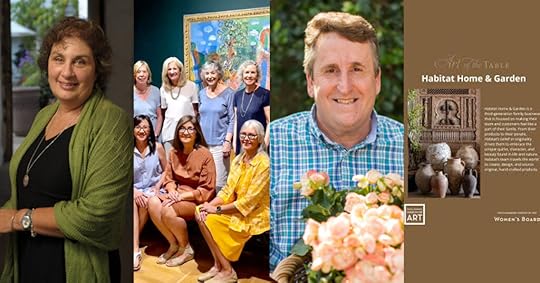
The post Pearl Chase Society & Art of the Table appeared first on Elizabeth Appraisals.
May 27, 2025
Art Pottery of the Arts and Crafts Movement
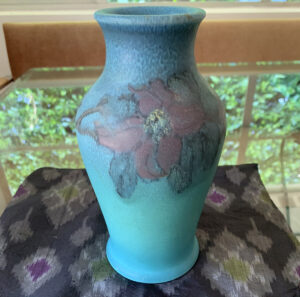 ES owns a eight-and-a-half-inch tall matt blue vase accented with a purple peony design with the “flame” mark for Rookwood pottery. The date stamp reads 1926. ES, your little vase represents a worldwide rise of a new style of ceramics, Art Pottery. This international art movement began in the late 19th century, evolving till the mid-20th century.
ES owns a eight-and-a-half-inch tall matt blue vase accented with a purple peony design with the “flame” mark for Rookwood pottery. The date stamp reads 1926. ES, your little vase represents a worldwide rise of a new style of ceramics, Art Pottery. This international art movement began in the late 19th century, evolving till the mid-20th century.
Female artists and creatives became instrumental in the craze for ceramics of this era. One great example is the founder of Rookwood Pottery in Cincinnati, Maria Longworth Nicols (1849-1932). As an amateur she painted on unfired white porcelain, a genteel hobby in her day for wealthy females at home. For a half of a century she lead her pottery company to international success. Rookwood won the International Gold Medal at the world’s fair, the Exposition Universelle in Paris in 1889. The firm closed its doors in 1967. David Rago’s book American Art Pottery: The Golden Age 1880-1920 states, “No single company achieved so much for so long as Rookwood, which put artwork above commercial considerations.”
Art Pottery and the Arts and Crafts MovementArt Pottery serves as a concrete example of the philosophy of the Arts and Crafts Movement. Its roots come from England in the writings of the polymath John Ruskin and the Pre Raphaelite artists in the second quarter of the 19th century. They espoused a return to handmade crafts, and simple Gothic traditions in architecture and design, opposed to industrialization and machine made objects. The philosophy emphasized the dignity of labor and purity of art. Art pottery claimed to be handmade or decorated by hand. Although also a factory, Rookwood stressed the human element in every pot created.
The diversity in the functions of tableware required in the dining rooms of the late 19th century to 1920s led to unique forms in ceramics. Consider a centerpiece bowl with a flower frog. The technological advancements of the era led to unique glazes, innovative colors, and female-inspired designs. Interior decoration became not only the realm of the female, but females became the leading consumers of fine ceramics.
ES’s vase bears the monogram for Rookwood artist Margaret Helen McDonald (1913-1948). Over half of Rookwood’s craftspeople were women, as were most of founder Nichols’ management team.
A Truly International MovementArt Pottery from all over the world sat on the stages of the hundreds of World’s fairs held throughout the globe. At the 1876 Centennial Exhibition in Philadelphia, Japanese, Chinese, Italian, French, Middle Eastern pots showed alongside American pots. Rookwood, for example hired Japanese potter Kataro Shirayamadani who moved to Cincinnati.
Art pottery borrowed design elements from many cultural traditions as well as objects created in the Arts and Crafts style, Art Nouveau, and Art Deco. ES’s vase gives an Art Deco feel, in a later date for Art Pottery. Notice the purple peonies underneath the mat glaze, yet on top of the blue of the vase.
The potter starts with an unfired vessel called greenware, painted with an underglaze slip (clay) and a colorant. Then the mixture of slip and color is dried and ground, and reconstituted in water, and used as a paint color in lighter and darker hues to create a background. Each color the potter intends to use as part of the design is mixed, dried, and reconstituted. Design is layered on, then the almost finished vase, called biscuit, goes to its first kiln firing. Then it’s glazed, and fired again. The final firing fuses the overglaze to the surface of the clay.
Rookwood’s LegacyRookwood became known for innovations of glazes, colors, and especially for their most popular “Standard” style of glazing and designs. You might have seen the brown and tan glazed vases by Rookwood with portraits of late 19th century Native Americans. Or florals and insects, with an earth toned background combined with a warm colored painted decoration under a brilliant glaze, most popular from 1883-1909.
The bottom of ES’s vase bears the signature Rookwood flame incised mark, XXVI (the date 1926), and the model shape number as well as an “E,” a SIZE letter. A is the largest size in that shape, F is the smallest.
Rookwood’s founder Maria Longworth Nicols had interest in all the arts. She was the first female founder of an arts festival: The Cincinnati May Festival. Her second marriage was to a diplomat in Europe. She died in Paris, and her progeny are British and French nobility.
The post Art Pottery of the Arts and Crafts Movement appeared first on Elizabeth Appraisals.
May 25, 2025
Summer Solstice Celebration
Board President Justin Gunn, mask maker and puppetmaster Emma-Jane Huerta, Festival Director Olivia Sorgman, and Executive Director Penny Little talk about Santa Barbara Summer Solstice parade and festival, June 20-22.
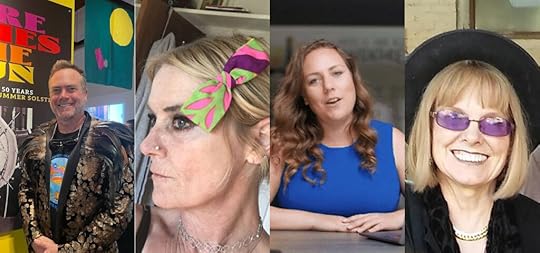
The post Summer Solstice Celebration appeared first on Elizabeth Appraisals.
May 18, 2025
Moving Miss Daisy and Chuck Graham
First, owner Glenn Novack share the latest news about Moving Miss Daisy. Then Chuck Graham, author, photographer, and longtime Channel Islands National Park guide, talks about his upcoming presentation, From Sea to Sanctuary: Chuck Graham Chronicles the Healing of the Channel Islands, at the Santa Barbara Maritime Museum on Thursday, June 26.
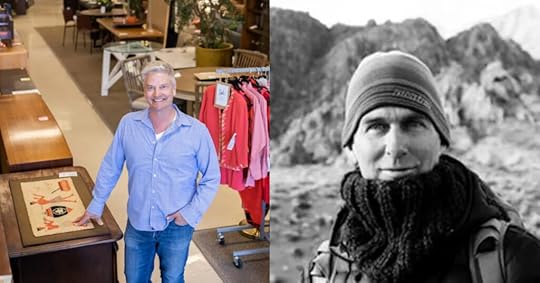
The post Moving Miss Daisy and Chuck Graham appeared first on Elizabeth Appraisals.
May 13, 2025
American Stainless and Sterling Flatware Hot Today
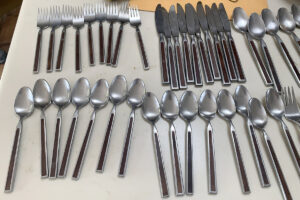 DS owns a set of Stanley Roberts International House of Design stainless flatware accented with inserted rosewood running down the handles. Very modern, and hot today, as American modern stainless and sterling flatware is sleek and simple—desirable in the market. Plenty of 1950s and 1960s wedding sets of both stainless and sterling flatware services exist. Hint: your jeweler will professionally polish the sets, if damaged.
DS owns a set of Stanley Roberts International House of Design stainless flatware accented with inserted rosewood running down the handles. Very modern, and hot today, as American modern stainless and sterling flatware is sleek and simple—desirable in the market. Plenty of 1950s and 1960s wedding sets of both stainless and sterling flatware services exist. Hint: your jeweler will professionally polish the sets, if damaged.
Stanley Roberts International House of Design became the largest importer of stainless flatware in the US till the early days of the 1970s. They took advantage of the cheap, exquisitely precise laborers in Japan and Korea. DS’s set is marked with the pattern name “Kamaran” and ‘Stainless Japan.’ The whole set has two market values: worth $1,000 (service for twelve) to the Palm Springs midcentury collector, and $200 to the garage sale collector.
Other fabulous MOD designs by Stanley Roberts include the pattern called “Cycles” with a long wide “O” shape for the handles. The “Maestro” pattern came with an inch-and-a-half thick flat handle with geometric raised designs of embossed diamonds in circles. My mother’s neighbor, Mrs. Martorella in Deerfield Illinois, decorated in the latest modern styles, setting her table with these patterns.
American flatware, both the modern sterling and stainless patterns, show a resurgence in today’s market. First modern patterns in the 1930s came from France and Denmark. US flatware companies didn’t clue up to the modern market till the mid 1950s. Then they seized the optimum opportunity. During WWII the US stockpiled silver for use in electronics, after the war the government sold for reasonable silver prices. US silver flatware companies bought, realizing the eras previous to the mid 1950s considered sterling silver flatware a luxury commodity. Only the wealthy set a table with sterling. After WWII the middle class could afford silver flatware. The media capitalized on this, advertising to brides, encouraged by the dual powerhouses of etiquette, Emily Post and Amy Vanderbilt. Sterling flatware, in a certain pattern, with each bridal guest buying one place setting, became recommended as de rigueur!
Patterns made by great American booming sterling flatware companies in the midcentury got copied in stainless. They did some tweaking to avoid copyright issues. Some of the finest American designers worked for the sterling manufacturers, such as Raymond Loewy.
Some ultra-modern American patterns presented to a couple for a 1950s or 1960s wedding: 1948 Towle, “Contour” 1954 “Theme” 1956 “Celeste” 1953 International Silver “Silver Rhythm” 1957 Gorham “Stardust,” and Wallace “Discovery”Stardust appeared like it sounds: a simple handle with star patterns, copied in stainless and on chrome plated utensils you bought at Kresge’s. On that note, the best stainless flatware contains ten percent nickel, making it more durable, resistant to bending—think of an ice cream spoon. Nickel offers protection against corrosion and creates luster and shine. Stainless flatware with no nickel is cheaper and found in fast food restaurants! DS’s stainless is heavy, indicating nickel.
On the other hand, Reed and Barton made the finest, heaviest, and most expensive modern sterling flatware pattern in 1958. It became as popular, as it was pricey, so elegantly simple, that it’s highly collectible. Designed by Danish John Prip and sketched by none other than Gio Ponti. The favorite and distinctive “Vision” of 1961 was, and still is, the most unique. The handle is canted to the side instead of laying flat on a table. Thus the fork or spoon bowl is at right angles to the handle!
Valuable Flatware Hints:People should use their sterling every day, just like pearls should be worn often. If you put stainless and sterling flatware together in those baskets used in a dishwasher, the sterling comes out spotted. DS’s stainless pattern named “Kamaran” has a wood insert and shouldn’t be soaked. Dishwasher detergent leaves a white haze on all flatware. On sterling it’s almost impossible to polish away. Detergents that contain lemon or citrus additives aren’t good for sterling. Neither is “saran” wrap, although as an appraiser I see drawers of sterling wrapped like that. Over time the wrap and sterling will fuse. Drying immediately after washing by hand is always the best practice.
The post American Stainless and Sterling Flatware Hot Today appeared first on Elizabeth Appraisals.
May 10, 2025
AlloSphere
Museum of Contemporary Art Santa Barbara Board President Frederick Janka and Dr. JoAnn Kuchera-Morin, Director and Chief Scientist of the AlloSphere Research Facility and Professor of Media Arts and Technology and Music at UCSB discuss her thirty-foot diameter, three-story high metal sphere inside an echo-free cube, designed for immersive, interactive scientific, and artistic investigation of multi-dimensional data sets.

The post AlloSphere appeared first on Elizabeth Appraisals.
May 8, 2025
Cringeworthy Midcentury Table Lamps
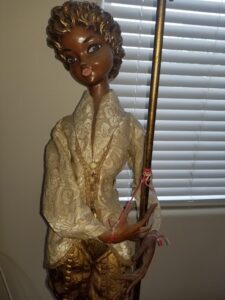 What one object personified KITSCH in a midcentury living room in the 1940s to early 1950’s? Those figural lamps that make us roll our eyes today, those non-politically correct, exotic sculptural lamps make us cringe. This article discusses cringeworthy midcentury table lamps that skate on the edge of tastelessness out to the borderland of the unimaginable.
What one object personified KITSCH in a midcentury living room in the 1940s to early 1950’s? Those figural lamps that make us roll our eyes today, those non-politically correct, exotic sculptural lamps make us cringe. This article discusses cringeworthy midcentury table lamps that skate on the edge of tastelessness out to the borderland of the unimaginable.
Some of the great designers of the late 1940s and early 1950s dabbled in lighting but wisely left the field to lesser geniuses. Those market savvy creators sold lamps to middleclass homeowners, a bunch of retail starved “sitting ducks”—they didn’t buy much during the clutch of the War years. Lamp creators felt free to become non-serious middle to lowbrow designers. They ran with themes, materials, and design elements considered NOVEL. In fact, novelty was the point! These figural lamps, exotic or nude themes, are often called novelty lighting fixtures.
Here’s list of a few types of “innovative”—a nice way to put it—mid-20th century lamps: the hanging chandelier with clear plastic thread holding tiny rivulets of oil drip, mimicking rain, the gaudy painted ceramic mallard duck on the wing with a lightbulb inside his body, wall mounted, or the Revolutionary War Minuteman whose rifle continues to support the shade shaped like a regimental drum, or the girl’s bedroom lamp with the automaton spinning ballerina in a bottle for the base. All eye-rollers.
Un-PC Pairs of Lamps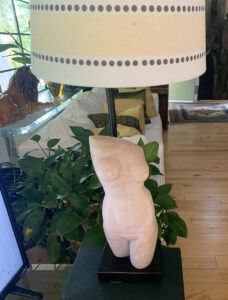 A pair of identical or thematically matching lamps was important in this era as consumers admired proportion and balance. Pairs of lamps with figural themes became popular in the late 1940s into the 1950s, such as a pair of Chinese male and female Coolies, a matador proudly displaying a fantastic male physique and a anatomically correct bull, a pair of sinuous Balinese dancers, elbows akimbo, male and female, and, sadly, a cowboy and an ‘Indian,’ or a pair of exotic brown snake charmers, male and female, cross legged, their baskets containing a snake. Not to mention the nude female torso lamps of the era.
A pair of identical or thematically matching lamps was important in this era as consumers admired proportion and balance. Pairs of lamps with figural themes became popular in the late 1940s into the 1950s, such as a pair of Chinese male and female Coolies, a matador proudly displaying a fantastic male physique and a anatomically correct bull, a pair of sinuous Balinese dancers, elbows akimbo, male and female, and, sadly, a cowboy and an ‘Indian,’ or a pair of exotic brown snake charmers, male and female, cross legged, their baskets containing a snake. Not to mention the nude female torso lamps of the era.
A client sent me photos of naked Classical female Greek or Roman themed lamps that skate close to the edge of head shaking. Due to the fact that they stay clear of running the electrical wiring pole though the figure and into the neck of a nude female torso, I give these lamps a greenlight and call them semi artistic. Many such Grecian Style nude figural lamps have the pole sticking through the neck which negates any pleasing sculptural beauty. Should you believe a light fixture resembling a white Greek Classical sculpture is beautiful, you also expect the lamp to be an novelty in its day. Novelty became a marketing tool. Classical Greece and Rome were in fact popular as design motifs in the 1940s, early 1950s.
Yasha Heifetz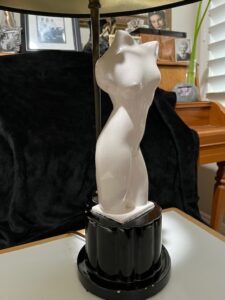 The pair of lamps, of which one is pictured, are highly glazed white ceramic on black mock-columnar bases. The color scheme is emblematic of the change in the late 1940s design from the Deco (black and white) to the Modern pastel colors. The shape is unguent, slightly biomorphic, and surreal. The shape gives a nod to highbrow Grecian art. The nude Classical torso leads me to suspect the designer is Yasha Heifetz. When I first saw his name I thought—boy, and he played a mean violin as well. But this is Yasha and the violist is Jasha.
The pair of lamps, of which one is pictured, are highly glazed white ceramic on black mock-columnar bases. The color scheme is emblematic of the change in the late 1940s design from the Deco (black and white) to the Modern pastel colors. The shape is unguent, slightly biomorphic, and surreal. The shape gives a nod to highbrow Grecian art. The nude Classical torso leads me to suspect the designer is Yasha Heifetz. When I first saw his name I thought—boy, and he played a mean violin as well. But this is Yasha and the violist is Jasha.
Particular lamps designed by the (un-musical) Heifetz are coveted today. Yasha, a clever wood craftsman, made his nude figural shapes in wood, in pairs for lamp bases straight out of his woodworking studio. He kept his factory and studio in Connecticut, but opened his showroom in Manhattan in 1938. For approximately 25 years he created 4,000 unique lamp designs and some furniture and decorative art. His career got off to a legitimately highbrow designer’s start because he won the Museum of Modern Art’s Award for lighting design 1950-1 with ten of his table lamps. These go for big bucks today, created in wood, bronze, ceramic, and hammered brass. Then he needed to make money, and sell, so novelty became the guiding light.
His Plastic Ceiling Lamps Also Coveted and PriceyHe used spun acetate for hanging fixtures in spaceship and flying saucer forms, two toned. He called this style Rotoflex, similar, if not a snatch and grab, to those from the highly respected British design collaborative team of Sylvia and John Reid. The Reids, architects, furniture designers, and design consultants, called their spun acetate hanging fixtures Rotaflex, and are in the permanent collection of the Vicotria and Albert Museum.
Heifetz’ vintage spaceship style chandeliers sell upwards of $8,000 as they are sleek, geometric, and NOT kitschy. Pairs of “novelty” figural table lamps of his, however, unless they’re his carved wood biomorphic or cubist nudes, sell for $1,500 the pair or under.
The post Cringeworthy Midcentury Table Lamps appeared first on Elizabeth Appraisals.
May 6, 2025
Porcelain Faced Doll Too Lifelike To Stomach
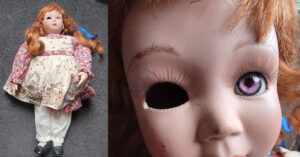 Confession! I have a doll phobia. They call it “paedophobia,” an intense irrational fear of a humanoid form when appearing too realistic, seemingly too close to becoming one of US. In fact, the more realistic the doll, the more frightened I become. Thus, when JP sent me a shocking doll photo, lacking an eye, I almost collapsed on my computer. First let me explain my reaction, then I’ll answer my reader’s request to research and put a value on her damaged-eye doll. By the way, she wrote that the eye is still rolling about in the head.
Confession! I have a doll phobia. They call it “paedophobia,” an intense irrational fear of a humanoid form when appearing too realistic, seemingly too close to becoming one of US. In fact, the more realistic the doll, the more frightened I become. Thus, when JP sent me a shocking doll photo, lacking an eye, I almost collapsed on my computer. First let me explain my reaction, then I’ll answer my reader’s request to research and put a value on her damaged-eye doll. By the way, she wrote that the eye is still rolling about in the head.
My first negative experience with a doll happened in San Diego. My longtime colleague Shawn and I worked late in our second-hand shop. At 9 pm I saw a dresser we recently purchased emitting an eerie green light from the bottom drawer. “Shawn! Come down from the office!” We both witnessed an old porcelain-faced doll in that drawer, off-gassing with a uranium colored light emission. Wouldn’t you develop a doll phobia from that moment on?
The Seat of UneaseIn 1970 Masahiro Mori, an early professor of robotics, coined the term “The Uncanny Valley:” the closer AI or robots are to lifelike humans, the creepier we find them. In 2025, with current “artificial” technology’s peaks and valleys, we may experience much more fear around imitations of “being human.” Dr Mori said that ambiguity is the seat of the unease: is it one of us or one of THEM? If a humanoid object does something out of human character your stomach revolts. Imagine a mechanized clown doll bending backwards, and upside down, crablike, creeping toward you on all fours.
Many horror movies feature dolls, meant to bring on panic attacks and terror: Puppet Master, Annabelle, and, of course, Chucky. Those of us who hate to see human form maligned hate those type of movies. Like all irrational fears, no one knows the origin. The prescription for recovery often centers on constant exposure, not welcomed in my case. Echoing Murphy’s law, I often receive calls to appraisal a doll collection.
Now, the Doll in QuestionA California dollmaker made her in the 1980s, a lady named Maurita Earline Brohmer, or she is also known as Earline Maples Brohmer (1938-2012). Born in Missouri, Brohmer relocated to Turlock, began a screen-printing business, and taught dollmaking classes. From 1983-2006 Doll Crafter magazine published her articles about how to make a porcelain faced doll. In March of 1999, Earline presented a three-day workshop in Menlo Park at a shop named Looking Glass Dolls & Bears, where students sculpted a head, hands, and feet with tools and supplies provided, for $300. Stranger than any coincidence, the very day the reader sent me that photo of Earline’s doll, it was exactly 26 years from Earline’s class in dollmaking.
One of the rare surviving doll shops, I wrote to the Vintage Toy Shoppe (est. 1975) in Richmond, VA. They DO buy antique dolls. Some of their vintage dolls, for example, are pricy: German artist Annette Himstedt eighteen inches tall dolls sell from $3-4k. Then there’s a limited-edition model, with porcelain face, German blown-glass eyes, 1997 date of creation, hand-knotted mohair wig, and a Belgian lace frilly dress, selling for $4,300 at the Richmond Virginia Vintage Toy Shoppe. I cannot imagine paying $4,000 to be endlessly haunted.
The type of doll the reader owns is indeed a porcelain faced doll, with porcelain hands and feet. Looks like she wears her original outfit, which makes a difference to a collector. The body of some dolls might be vinyl, composition (a mix of wood shavings and gesso), or resin, and some have an amateur of wire with which one can bend arms and legs, such as the series called Barefoot Children at the Vintage Toy Shop in Richmond. At this point, those Barefoot Children look too lifelike for me to stomach. The value of the reader’s doll—if she sent it to a doll hospital for repair—would be $75. I asked the reader to give the Vintage Doll Shop a call and ask if they know of any repair locations and fix up that eye before the doll scares another poor soul!
The post Porcelain Faced Doll Too Lifelike To Stomach appeared first on Elizabeth Appraisals.
May 4, 2025
Jigsaw & Jane: Thirteen Years of Murder and Mayhem with Badge Number One
Award-winning author Jane Howatt talks about her new book Jigsaw & Jane: Thirteen Years of Murder and Mayhem with Badge Number One.
Watch Video
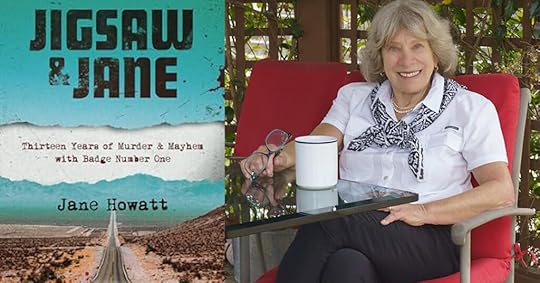
The post Jigsaw & Jane: Thirteen Years of Murder and Mayhem with Badge Number One appeared first on Elizabeth Appraisals.
April 29, 2025
Fine Art Print Market A Good Investment
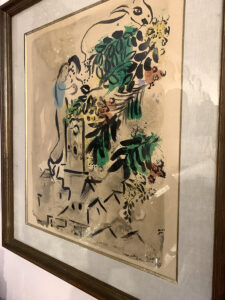 BL, a budding Gen Z art afficionado, asked if the fine art print market is a good investment. A great question. The answer is YES for some types of prints created in select eras in certain styles. For example, pop art is strong today. Let’s look at the world of prints, often called “multiples,” and see what sells NOW. Last month we saw top attendance and top dollars spent at three major print fairs.
BL, a budding Gen Z art afficionado, asked if the fine art print market is a good investment. A great question. The answer is YES for some types of prints created in select eras in certain styles. For example, pop art is strong today. Let’s look at the world of prints, often called “multiples,” and see what sells NOW. Last month we saw top attendance and top dollars spent at three major print fairs.
Printmaking comes in many forms, often a collaborative process between the artist and the printer. They call the same image printed in a sequence an edition—a numbered, limited series. Most connoisseurs consider a limited edition print an original work of art. Look for a fraction: 1/10 means the first strike in a series of ten, often handwritten in the margin. Look for an original signature, not just a signature as part of the image located “in the plate.” An “open” edition, on the other hand, isn’t a limited number of prints nor “numbered.” These are never as valuable as a numbered limited edition print, not usually signed by hand.
The artworld’s classic methods/mediums of printmaking:Etching, engraving, woodcut, dry point, aquatint and mezzotint are “intaglio” prints, meaning an image/drawing/composition is incised in a surface (in copper for example). Ink is applied directly to the incised surface, and the plate is pressed onto paper. The sunken deep lines “hold” the ink and with pressure create the image. An engraving/etching and a woodcut are typically an older style of printmaking associated with Old Master prints of late 18th century or earlier in the Western tradition. Think Albrecht Dürer, Rembrandt, and Francisco Goya.Lithograph: a drawing made on a stone using a special ink. The stone is then washed with acid, which penetrates the areas not drawn on. Rolling with printing ink, the ink “sticks” to the drawn parts, over which paper is pressed. David Hockney uses lithography extensively.Screenprint or Serigraph: a reproduction of an image via a stencil. For example, a photograph such as those portraits made by Warhol. The “screen” is a screened frame that bears the reversed image. Serigraph is a lesser valued version of this process, used by Peter Max.Fine Art Print Market Growing Among Younger BuyersRecord attendance last month at NY’s International Fine Print Dealer’s Association Print Fair (21,000 visitors) occurred at the same time as the new Brooklyn and traditional Paris Fine Art Print Fairs. Auction houses saw younger buyers springing for affordable prints, especially in the Pop Art style, in online bidding. Twenty-to-forty-year-old buyers don’t only buy ultra-contemporary works but classic prints by Modern Masters (artists working 1920—1970s) such as Miro, Baldessari, and Hockney. My first print fair in the mid-1980s showed almost exclusively Old Master etchings and engravings. Now Old Master prints capture only twenty-five percent of the market.
One dealer at the New York Print Fair reported that a Gen Z buyer admired his great aunt’s classic Miro collection as a teen, vowing to buy his own Miro when he came of age. Modern Master prints are the bestsellers across the market (classics: Miro, Picasso, Hockey). Second bestsellers are contemporary prints, works of the last forty years. Lesser sellers are Old Master prints, except Rembrandts, which retain their strength in the market. The top selling artist in the print category? Andy Warhol, from 2015-24, with total sales of $501 million. After Warhol, top artists in this category are Picasso, Banksy and Jeff Koons, as well as the big bold iconic images by Lichtenstein and the colorfully accessible work of David Hockney.
My Buying AdviceBL, if money were no object, I recommend looking into Lichtenstein’s “Nude” series (1994) and Warhol’s “Endangered Species” Series (1983). Another name to purchase? George Condo. His surreal work will put you in mind of Salvador Dali and his cubist works in mind of Picasso. Condo is capitalizing on icons, as only a true Pop artist would.
Finally, BL, to purchase affordably, check out museum fundraisers. Notable museums often commission a printmaker to create an edition, sold to raise funds. These prints are typically works by important mid-career living artists, benefitting the museum and their reputation at the same time, and also, because of a limited “run” (a small edition of under, say 250) will increase in value.
The post Fine Art Print Market A Good Investment appeared first on Elizabeth Appraisals.
Elizabeth Stewart's Blog
- Elizabeth Stewart's profile
- 5 followers



